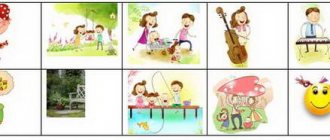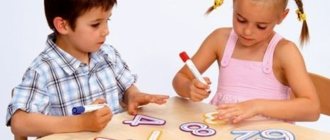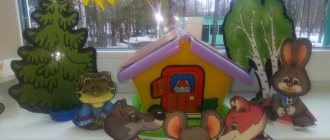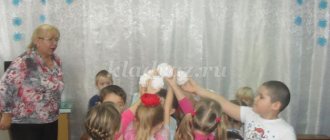When to start teaching your child how to tell time
For a preschooler, the concept of “time” is abstract. You cannot touch it with your hands, taste it, or hear it. At the same time, it plays a very important role in people's lives. After all, mom often says: “We must hurry, we don’t have much time” or “The time will come, you will get older, and then you will understand.”
“What kind of animal is this time?” - the kids begin to become interested. And just when this interest has appeared, the moment comes when you can teach your child to understand time by the clock.
The process is gradual. First, it is necessary to give knowledge about the seasons, time intervals, then about the clock, about the digital dial, etc. But first things first.
From the age of one and a half years, the baby begins to verbally reflect the categories of time: now, first, now, then. It is the adults who are next to the child who help highlight these signs, which together create an image of time. Children 6–7 years old are already actively using tense adverbs.
Temporary concepts are given to the child in accordance with age and in proportion to what he is able to learn:
- 1-3 years – distinguishes the time of day: day, night.
- 3-5 years – understands the concepts of evening and morning; distinguishes between seasons: winter, summer.
- 5-7 years – determines spring, autumn by seasonal changes; distinguishes between time units (hours, minutes, seconds); distinguishes its course (fast, long, often, rarely, yesterday, today, tomorrow).
Therefore, a thorough acquaintance with clocks with hands should begin after 5 years.
At the same time, it is necessary to develop a “sense of time” - the ability to evaluate time intervals and navigate in time without aids. This quality will be useful to the child when studying at school.
Methodology for the development of temporal representations of preschoolers in different age groups
Methods for developing temporary relationships are described in detail in the works of T.I. Erofeeva, A.A. Stolyara, L.S. Metlina, T.D. Richterman and others. This paper provides a brief overview of the “Program of Education and Training in Kindergarten” based on the work of A.A. Carpenter. There are several aspects of these techniques that reflect the gradual development of the child’s analytical apparatus:
1) familiarizing children with the parts of the day,
2) familiarization with the calendar,
3) developing an understanding of time sequences.
For reinforcement, didactic material is used, which consists of pictures with specific activities that are associated with a specific time of day. Poems and stories are read, which describe the child’s actions characteristic of each part of the day. Logical word games are also used. For example: in the game “Missing Word,” the teacher deliberately misses a word: “We have breakfast in the morning, and lunch...?”
After mastering this material, you can move on to familiarize yourself with the adverbs “today,” “yesterday,” “now,” “tomorrow” and associate their sequence with the daily cycle of three days. To do this, you need to talk about one and bright event for children three times in the present, future and past tense. Gradually, by the end of the year, the children in the middle group should develop a basic understanding of the fluidity and continuity of time.
It should be noted that systematic work with the calendar helps children develop knowledge not only about the current date, but also about the fluidity of time, its periodicity, the recurrence of months and the irreversibility of time processes, i.e. practically gives an idea of the main characteristics of time.
The development of a sense of time, as mentioned above, is a necessary condition for any activity. Therefore, children need to create various situations, focusing their attention on the duration of various vital intervals, clearly showing what can be done during this time, teaching children to measure and then evaluate time intervals in the process of activity, and carrying out simple preliminary planning of their actions. In general terms, we can highlight a number of foundations for the successful development of a “sense of time”:
ability to estimate time intervals without a clock.
Organization and methodology of work:
1) familiarizing children with durations of 1, 3, 5 and 10 minutes, while using a stopwatch, an hourglass, and a construction clock for children to perceive the duration of the indicated intervals;
2) ensuring the experience of the duration of these intervals in different types of activity;
3) children learn to perform work within a specified period (1, 3, 5 minutes), for which they were taught to measure time and estimate the duration of an activity, and regulate the pace of its implementation.
The work is carried out in stages.
The program material for the first 3 lessons includes the following tasks:
1) introduce children to the duration of 1 minute;
2) teach the ability to control time using an hourglass in the process of performing various activities;
3) create a feeling of satisfaction from the ability to complete a task on time.
Work with 3 and 5 minute intervals is structured in a similar way. In this case, children, as a rule, work with an hourglass. It is more convenient to start using a digital watch by studying the 5-minute interval, because this interval in hours is easy to see. Based on the acquired ideas about a 1-minute interval, children study the model of a clock. To do this, they usually use a model whose arrows can move freely. Gradually the classes become more difficult. In order for children to use time as a regulator of activity not only in classes, but also in independent activities, their knowledge of the hourly routine of life in kindergarten is clarified. Children move the hands on the mock-up clock and, setting the appropriate time, tell what they were doing at that time. Thus, in the process of activities and games, children develop their first planning skills. It is worth noting that when teaching children to be precise in time, it is necessary to strictly adhere to the scheduled deadlines, since any deviations from the scheduled time are perceived especially sharply by them. The child will be able to learn the time sequence of activities and events when he practically acts with the time links proposed to him. He will be able to compare the current state with the previous and subsequent ones only when each link of the observed time sequence is perceived not in itself, but in a system. To do this, the teacher must explain the material in the sequence necessary for the children, help the children reproduce, supplement and restore it, and also gradually achieve independent determination of the time frame for their activities.
Source
How to explain to a child what time is
If you ask an adult: “What is time?”, he may answer that it is a certain parameter, or a certain interval between events, or he will express some other philosophical reflection.
Have you ever wondered how a child will answer this question? What is the concept of “time” for him? Do a simple experiment and ask your children. The answers may be very interesting.
To gradually give your child an idea of time, it is necessary to form the following concepts:
- Times of Day;
- season;
- units of time;
- passage of time (fast, long, often, rarely, yesterday, today, tomorrow).
These concepts are given to preschoolers by parents and kindergarten teachers. To do this, they can use the following techniques: conversations, stories, games, poems, riddles. Before explaining clock time to a child, it is important to prepare him for the perception of time in a broader sense.
Seasons
At 3 years old, a preschooler begins to associate weather with seasons. At first, these are primary and pronounced signs: in summer it’s hot, in winter it’s cold.
With growing up, the amount of information gradually increases, and by the age of 7, the child knows the number and order of seasons, the number of months in a year, the order of months, and the classification of months by season.
Children receive all this information by watching the weather, looking at illustrations, memorizing poems, and listening to riddles. For better memory fixation, each month is associated with a natural phenomenon, human activity, or some holiday.
For example: Mom explains to the baby: “Winter has come. Look, it's snowing outside. Let's put on a fur coat, hat and boots. Cold. Children are making a snowman. New Year is coming, we will decorate the Christmas tree, and Santa Claus will bring gifts.”
Particular attention is paid to the calendar. With its help, the child will be able to clearly understand long periods of time: day, week, month, year.
Four times of day
Children begin to learn simple concepts of “day and night” before the age of 3 years. Later they begin to understand the meaning of “morning - evening”. To formulate these concepts, it is recommended to use pictures with the actions of animals or people at different times of the day, didactic games (“When does this happen?”), riddles, and nursery rhymes.
For example, guess the riddle: “The children went for a walk, they are observing. The sun is shining brightly in the sky, the birds are singing happily. (Day)
Note: In order for the child to correctly form concepts about the time of day, before napping you should not automatically say “Good night”, you should wish “Good sleep”.
Hourly intervals
At the age of 5 - 7 years, you can teach children to understand time by clock. How to determine the exact age point?
If a preschooler himself begins to show interest in watches, asks to explain what the watch shows, where the hands are, when his favorite cartoon starts, what time dad will return from work, then your child is ready to learn complex information about hour intervals.
And in order for this information to contribute to the perception of time, and not a superficial understanding of the “numbers” on the clock, the preliminary preparation described above is precisely important.
We begin direct training
Before. When starting training, it is very important to remember a few basic requirements:
- Never put pressure on your baby . It is important to strike a balance between training intensity, rewards, and rest. Classes should always be interesting and bring joy.
- Don't have too long training sessions . It is most convenient to spend a few minutes mastering counting skills and dividing complex material into simpler segments.
- Always show the practical importance of using the skill learned . For example, the baby will be able to determine for himself when his favorite cartoon starts or the time allotted for games.
Don’t forget about the numerous online tools and special toys that help you absorb new information much faster. They can be easily found online or bought in a special store.
Introducing a child to a clock with an arrow
First, you need to explain to your child the purpose of the watch. For this, in addition to conversation, you can use small poems or riddles.
The clock will show us everything exactly,
You learn to understand them urgently,
So that the question: “What time is it?” —
You could answer every time.
To motivate learning, it is better to buy a watch with a children's drawing. Go shopping with your child. Give up the right to choose in this matter to your baby. On the clock with which you will teach your preschooler to tell time, both hands and numbers should be clearly visible. In addition, the dial must have minute divisions (all 60).
Before the learning process, the child must have basic knowledge of time, be able to count, and know numbers. The concepts of “hour”, “minute”, “second” are given gradually, using visual aids (a clock or a layout) and are reinforced in practice.
What does the dial inform you about?
First you need to give information about the dial - that part of the watch that visually displays the time. Then, together with the preschooler, figure out what numbers are on the hour field, the peculiarity of their location in a circle.
To consolidate the acquired knowledge, it is useful to invite the child to draw numbers on a circle, which will serve as a clock template.
While the preschooler determines the location of each number and displays it on a paper disk, he organizes information about the circular hour scale.
Hour hand
The next stage is getting to know the clock hands. Count with your child how many hands there are on the clock. Pay attention to their length.
Focus on the names: “hour”, “minute”, “second”. Explain why they are called that. Please note that it is the short one that indicates what time it is and is therefore called “hourly”.
Do a little experiment: let your preschooler independently determine which of the arrows is moving fast and which is moving slowly. Draw conclusions together.
Be sure to explain and demonstrate clockwise and counterclockwise movements. Be sure to clarify that time always moves only forward, and the arrows only move in one direction.
Minute hand
After information about the hour hand, it is necessary to explain to the child the purpose of the minute hand. In this case, it is important to pay attention to the length of the hand (long) and purpose (shows minutes).
It is necessary to show where on the dial the time is measured in minutes. Then explain that 30 minutes is half an hour, and where the big hand is at that moment.
You should also introduce the “convenient secret” that there is a quarter hour. Move the arrow to show a quarter and correlate it with the number of minutes. Repeat with the next quarter and help the preschooler understand that the minute hand measures such intervals four times in one hour.
Only after a thorough analysis of the movements of the hour and minute hands, connect the information received together. As a result, a preschooler can and should learn that exact time is a logical combination of the digital indicators of the hour and minute hands.
Explaining the essence of time
By the age of three, children, as a rule, know what morning, afternoon, evening are, and how they differ. To teach this, you can use visual aids: cards, pictures, cubes, books. Tell your child when the sun rises, when it sets, and what we do at certain times of the day. For example, in the morning we wake up, wash our face, brush our teeth, and have breakfast. At lunch we eat soup and go to bed for the day.
In the evening it gets dark, the whole family has dinner, then the baby bathes, listens to a fairy tale, and goes to bed. As you know, children perceive new information better during play. Let your favorite toys (dolls, bears, bunnies) wake up, have breakfast, go for a walk, and go to bed. At the same time, talk about what time of day it is for the toys, explain why right now they should go to bed or wake up.
Interesting : We warn correctly about the punishment. Useful methods and advice from psychologists
Making watches with your own hands
A homemade watch will help teach your child how to tell time using a clock. How to make a watch:
- Cut out a circle from cardboard;
- We draw it into four equal parts;
- We divide the quarters into three parts;
- We write numbers on the dial from 1 to 12;
- Cut out arrows from cardboard;
- We attach the arrows using a button, a small nail or a bolt.
It's even easier to make a clock mockup using disposable paper or plastic plates.
It is very good if your child is your assistant. For him, this is additional motivation to learn new things.
Add variety to your learning - make your own clock
Another way to make the learning process much more interesting and memorable is making your own watches. They can be made from different materials; in most cases, cardboard or colored paper or wire are used.
The arrows can also be mounted on a beautiful plate. In this case, you can buy paints and paint the plate the way you want.
Another option is to make a beautiful watch with a dial on which the main positions are marked with pebbles, shells, leaves or other objects.
We teach a child to tell time using a simulator
It is not enough to explain to a child what and how the clock shows. Only a few children will understand the mechanism of telling time from the words of an adult. Children need to practice and understand in action how a clock with hands “moves” and what they communicate.
A self-made watch is perfect as a simulator. The child can easily cope with moving the arrows on the layout.
Both a craft watch and one purchased in the toy department can serve as a simulator. The main thing is that the numbers on the dial are large and the hands are removable.
Training with the small hour hand
First, we leave the short hand on the simulator and work on the concept of “hour”. For example: put the hand on the number 3, ask the child what number it is and explain that on the clock it means “3 o’clock.” For further reinforcement, move the arrow in a circle and let the baby voice the hour (number).
Teaching how to determine minutes
Next, the preschooler practices with the minute hand. To begin with, it moves it by 1-2 minute divisions. Having mastered the entire circle, we focus the child’s attention on the quarter indicators.
- We remind the child the concept of “half an hour” (the long hand is on the number 6 and this is “30 minutes”, “half an hour” or “half an hour”);
- Let's move on to the time interval “15 minutes” - a quarter (the long arrow is at the number 3);
- We explain the remaining minute intervals (we show the variability, offer to play and set the arrows yourself).
Note: This information can only be learned by a child who can count to 60.
Learn to tell time on a clock using two hands
If the child understands what and how the short and long hands on the clock show, you can combine the learned material. An adult needs to not only explain, but show in practice how to determine a given time (for example, 3 hours 20 minutes). The child first repeats and then completes the proposed tasks independently.
To connect the information received, you can use a fairy-tale context: “A big one came to the little hand, they became friends and began to tell the time together.”
We consolidate the result using games and tasks
Having studied the time by the clock, it is necessary to consolidate this information with the help of games and special tasks.
Examples of exercises:
- Complete the sentence: “In an hour...minutes”; “In a day...hours”; “In a year... months”, etc.
- “Name a couple of hours and minutes”: The presenter calls any number on the dial, and the player voices how many minutes it determines (number 4 is 20 minutes).
- "When?". The preschooler is shown pictures with different scenes, and he must show on the clock when this action occurs. For example, on the card there is a picture of a baby stretching near the bed. The participant in the game shows the rise time on the clock.
- “Find out what time this clock shows.” The preschooler is shown cards, each of which shows a clock showing a different time. It is necessary to determine what time the clock recorded.
Gradually, the images of time will be enriched by personal experience, training, and by the time the child starts school, he will have mastered such a complex but very necessary skill - telling time.
At what age is a child ready to understand time?
Obviously, it is best for a child to understand how to tell time by a clock before he goes to school. It’s good if the baby himself shows interest in this topic, asking his mother questions: “Is 10 minutes a very long time?”, “How soon will we go for a walk,” etc.
It’s great if the child himself shows interest in the topic of time, the structure of clocks, and asks his parents relevant questions
Before starting training, parents should give the child a general understanding of time (how it moves, what the past, present and future are, the time of day).
This is usually explained to preschoolers in kindergarten. However, not all children attend preschool or do so irregularly.
In addition, in order to understand how the clock works, the child must be able to count to 60 and know how the indicated numbers are written. It will also be great to understand counting with fives and tens (this is not necessary, but will be just perfect).
Therefore, the specific age at which you need to start learning to tell time using a clock cannot be stated unambiguously (each child is individual, as well as the pace of his development). Some people are ready for this as early as 5 years old, others only at 7 years old.
Where to begin
In a child’s understanding, time is a complex, non-existent concept; it cannot be touched or tasted. The baby understands that everything around him is changing, but he cannot measure or feel the changes.
The first thing you should start getting acquainted with is the basic division of time into the future, present and past. Use simple examples to explain these concepts to your child:
- Future: in the evening we will go for a walk.
- Present: We are playing now.
- Past: in the morning we had breakfast.
Explain the difference between them using clear and interesting words and examples.
Teaching time and consolidating material in a playful way
As you know, children perceive information best in a playful way, so parents should take care to create an interesting and fun learning process.
Using the constructor
You can purchase a special kit in the store, which includes a wooden construction set and a notebook with assignments. Thanks to the additional developmental materials that are in the notebook, the baby will not only master the dial, but also prepare for school.
The wooden construction set is a dial with numbers from 1 to 12 and from 1 to 24. The minutes and seconds are marked on the construction set, and there are also movable hands with which the baby can set the time. The constructor can be colored as you wish.
The child assembles such a construction set independently, which will initially help to interest him in the game.
Interesting online games
Today, many children tell time only by electronic mechanisms, because it is much easier. The online game “Learn Time” helps you understand what time a mechanical watch shows. The game invites you to look at an electronic watch and, among the proposed mechanical options, find one that shows the same numbers. After confirming the choice, the baby moves on to the next task.
The educational online game “Watches – Studying Time” introduces the young player to mechanical and electronic mechanisms.
The game is designed for children from 3 to 5 years old. Here you can see a mechanical clock in the shape of a house where a cuckoo lives. There is an electronic clock in the right corner of the screen. First, they determine the time on a mechanical clock, and then set it on an electronic clock. The baby needs to follow the view from the window in order to correctly determine the time of day.
Games to consolidate results
Reinforce your learning with simple practical tasks in a playful way. When performing a certain action: going to bed, waking up, setting the table for dinner, ask your child to watch and tell you what time the clock shows.
When turning on cartoons, a computer game, going on a visit or for a walk, clearly state the planned time interval: 15 minutes, half an hour, an hour - and pay attention to the location of the arrows.
Ask your child for help when doing household chores, for example, ask him to remind you to turn off the stove in 5 minutes, say that it’s time for dinner if the big arrow is on the number 6. Teach punctuality: when going somewhere, talk about the time for getting ready and traveling .
Here are some ways to master time categories playfully:
- " Tell me what time it is ." Set the time on the layout. Take a teddy bear, tell your baby that he is in a hurry to get home and asks what time it is. The kid must answer, if he can’t, help him.
- Make the exercise more difficult by changing the position of the hands on the dial. Repeat several times to consolidate the result.
- " Make a daily routine ." Take the clock model in your hands. Set the arrows to the time when the baby usually wakes up, then, moving their progress, discuss all the actions that he performs during the day, in the morning, at lunch and in the evening.
- " True False ". Place arrows on the layout, ask the child if it is correct that it is such and such a time. He must confirm or refute what was said. If he is in difficulty, ask leading questions.
- " Schedule ". Invite your child to start playing bus station. To dispatch the cars, he himself needs to set the clock hands to the specified time. Use whole numbers first, then complicate the task by using definitions such as “noon”, “quarter of an hour”.
"Cubes"
To play you will need 4 dice and our homemade clock. We throw the dice in pairs. The first pair of cubes will determine the hours, the second pair will determine the minutes. The time that has fallen must be set on a toy watch.
There are also interactive games with clocks on the LogicLike platform. We have more than 3,500 exciting tasks for children of preschool and primary school age that help develop logic, thinking, and memory.
Poems about time for children
It is very good to use short poems during the learning process to remember the basics of time. This will make it more fun and easier for the child to immerse himself in the process of learning this concept.
Here are the funniest and most interesting poems.
Hours and minutes will pass, They will gather together in a day. They have twenty-four hours, and the hands work wonders.
The arrow passes the first circle, - Noon comes to visit us, And she hurries again to mark hour after hour.
The arrow has passed the second circle, - Midnight came to visit us, The day passed, and the night passed, - They ran away for a day.
***
The seconds are counting, the Dwarf has taken the lead, but he doesn’t know yet how short a second is.
Look at the clock - The hands are not here for show: They indicated for us the Second, the minute and the hour.
A second is a thin one, A minute is a long one, And a short one is an hour: This happens every time.
Sixty seconds have passed - We have approached the minute. Well, sixty minutes together will give you a whole hour.
***
The walkers suddenly began. What happened, what happened? The arrows immediately stopped winding Day around the axle. The gray-eyed dial looked at them gloomily: “If you are not to blame, is someone still to blame?” “Maybe,” thought Roma, “the pendulum has no strength, try with your head down. Swing for so many years!”
***
There is a clock on the wall in the room. It is not hanging for decoration. And to the rhythm of knocking: tick-tock, tick-tock. Everyone is given a conventional sign. Day and night change outside the window. The dawn is wonderful. And then for a person all year round, the time has come for daytime worries.
Watch another interesting video about teaching time to children.
A child should be taught to value time and use it wisely from childhood. Ask him what good, useful or enjoyable can be done in an hour, a minute, half an hour. Don’t expect quick results, don’t rush the learning process: time orientation is a complex skill.
The smaller the child, the shorter the lesson should be. So that he quickly learns to understand complex concepts, learn to understand the movement of the mechanism, find out what time it is, buy him a bright wristwatch. This way the child will quickly begin to use the acquired knowledge in practice.










